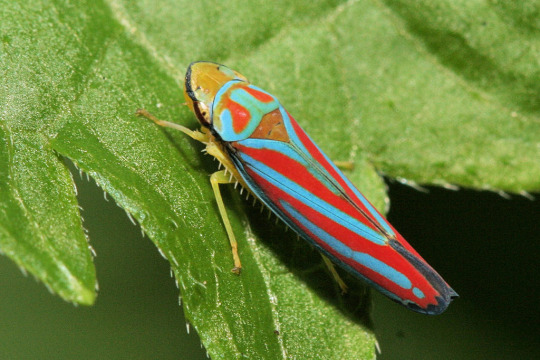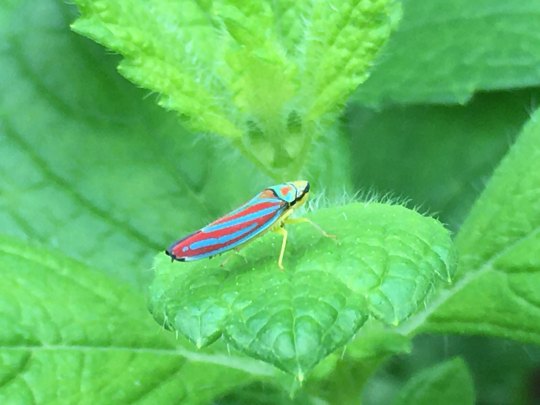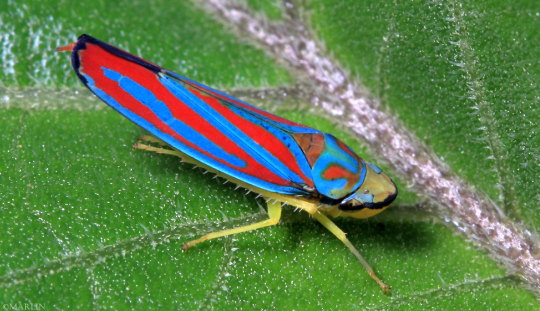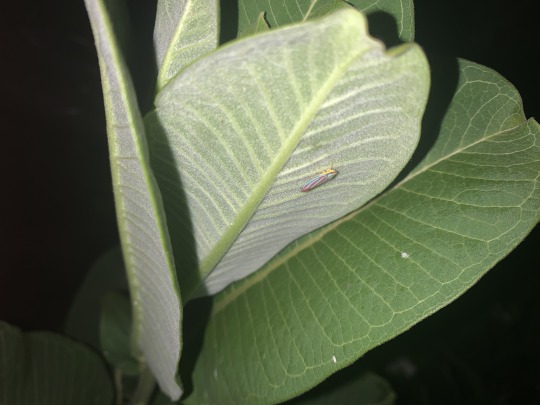#it is a red-banded leafhopper :)
Explore tagged Tumblr posts
Text
@treetreader submitted: Red banded leaf hopper in me garden!

What a beautiful friend! I wish I were that colorful
287 notes
·
View notes
Text
I love how vibrant these bugs are

(Source: iNaturalist)
22 notes
·
View notes
Text


Look at these beautiful little bugs I could cry. Red-banded Leafhoppers.
#stare at a plant long enough and you start seeing all sorts of critters. amazing. they look like candies....#they're on basil and parsley leaves if that helps to imagine scale. they're teeny. herb pot is like forest to them.#bugs#red banded leafhopper#mine#nature photography#wildlife photography
9 notes
·
View notes
Text




Candy-Striped Leafhopper (Graphocephala coccinea)...
#nature#my photography#red banded leafhopper#nature photography#leafhopper#wildlife photography#candy striped leafhopper#backyard nature#insect
7 notes
·
View notes
Text

I was lamenting this morning about not being able to see anymore leafhoppers or planthoppers because of the incoming cold. and then I decided to go bird watching and this fella jumped on my leg out of nowhere. miracles DO happen ...
3 notes
·
View notes
Text

red-banded leafhopper, Graphocephala coccinea
18 notes
·
View notes
Text

Red-banded Leafhopper – Graphocephala coccinea Photographed at DuPage County, Illinois. Size: 8.5mm
2 notes
·
View notes
Text
my phone which refused to focus:

Walks phone:

#undescribed images#Rjalker takes pictures#bugs#insects#bug photos#insect photos#leafhoppers#red-banded leafhopper
5 notes
·
View notes
Text
cool bug

cool bug
0 notes
Text

@alkaline-noodles submitted: This pretty lil guy chilling on my basil plant. North New Jersey
Excellent colors! They are a red-banded leafhopper :)
129 notes
·
View notes
Text


Lepidopterans, the insect clade including butterflies and moths, were among the invertebrate species seeded onto the planet's biome, in order to act as pollinators that allowed the numerous introduced plants to survive. While most of them adhered to this lifestyle and ecological niche, as ravenous leaf-eaters that metamorphosed into flying pollinators, a few began to experiment with more unconventional lifestyles.
Some of the stranger kinds included the caterpedes: a group of neotenic species that matured simply as larger larvae and skip metamorphosis altogether: filling niches as forest floor detritivores, folivores or occasionally even predators of other insects. And perhaps more unusual are the clade known as the Hemimetamorpha, or "half-changed", which do pupate and emerge as adults with proboscises: yet retain their silk glands ejecting silk through a spinneret located directly below the proboscis and between the labial palps, allowing them to construct nests or wrap their eggs in silk sacs for protection.
Many of the Hemimetamorpha do not develop wings, and instead, thanks to their piercing and sucking mouthparts, fill the niches of true bugs on Earth: as sap-suckers akin to aphids, leafhoppers or cicadas, predators of small arthropods, or even as as flea-like parasites on larger animals. And in the case of one clade, the spooders, they use their retained silk glands to spin webs to catch their prey, in a manner akin to their arachnid namesake.
The red-spotted skeeter (Arachnopapilo rubrum) is one widespread Middle Temperocene species, ranging well across the tropics and temperate zones of Gestaltia and Arcuterra. Despite appearances, it sports two ocelli, one next to each compound eye, large feathery antennae possessing olfactory receptors, and a proboscis, albeit a short, sharp one rather than the long, coiled ones of nectar-feeders, all of which mark its lepidopteran ancestry despite the otherwise lack of resemblance to them.
Female red-spotted skeeters spin webs among grasses and branches, waiting to ensnare flying insects that they then immobilize with digestive enzymes in their saliva, while males are smaller and nomadic, instead hunting by pouncing on their prey and traveling across larger areas of territory compared to the more sedentary females who prefer to stay in their webs. They are also more brightly colored, in order to entice a mate, as the larger female is not above preying upon a suitor she does not like, though occasionally, a male may resort to restraining a female with his own silk, immobilizing her long enough to successfully mate and fleeing before she escapes.
Once mated, the female wraps her eggs into a silk pouch, searches out a safe place with plenty of food, and leaves the egg sac there to develop with no further intervention. The young hatch out as fairly typical caterpillars, yet are carnivores like the adults, tracking down and ambushing other small insects, in particular ants due to their foraging trails being a reliable source of food that comes to them as they lie in wait, as well as their toxic compounds being sequestered by the larva for its own defense. With a nutritious protein-rich diet, the larva matures faster than a leaf-eating caterpillar, and is ready to pupate within a week or two, producing a camouflaged chrysalis that is attached to branches and stems and further disguised by bands of silk. After another 5-7 days it emerges as an adult, and is immediately ready to hunt for a meal within minutes, being wingless and thus bypassing the long vulnerable phase of waiting of their wings to unfold. Within the span of a month, another generation is fully-fledged and ready to breed: a rapid turnover vital for a species with high mortality rates and many enemies-- including members of its own species in both their larval and adult forms.
------------
#speculative evolution#speculative biology#speculative zoology#spec evo#hamster's paradise#species profile
52 notes
·
View notes
Text

with my hair and my clothes i feel like this leafhopper (red banded leafhopper, graphocephala coccinea)
8 notes
·
View notes
Text



A Candy-Striped Leafhopper (Graphocephala coccinea), aka Red-Banded Leafhopper, on a Magnolia Leaf...
#nature#my photography#candy striped leafhopper#nature photography#leafhopper#wildlife photography#insect#backyard nature
16 notes
·
View notes
Text





















Zuzu's Bug-ventures: Jersey Shore Edition Part 2!
I'm back from New Jersey and in total I ended up finding 43 different kinds of insects/spiders/isopods/etc. Not all of them are getting posted (some of the photos I took are so dogshit I can't in good conscience consider them internet-worthy.) But here is part 1 if you haven't seen it.
Anyway, there are a couple repeats from part 1, having found and taken better pictures of some of these bugs in the latter half of my vacation.
Restless bush cricket (Hapithus agitator). A repeat, but a much better photo. They mfers are SO NOISY. Also I spent an entire evening trying to get good photos of like 5 different spiders with my camera's terrible flash, none of which came out well. But this guy gets a perfect nighttime photo, apparently
Spotted orbweaver spider (Neoscona crucifera). Also a repeat. I ended up seeing about a dozen of these guys all over the boardwalk
Arabesque orbweaver spider (Neoscona arabesca). Another orbweaver, but different from the previous one. I really love the webs in these photos
Bellflower resin bee (Megachile campanulae). Cute
Cabbage white butterfly (Pieris rapae). We're old friends at this point, though this one doesn't look as cabbage-like as others I've found
Flea jumping spider (Naphrys pulex). I was sitting in a gazebo near the ocean and saw this fella walking around. Apparently I'm getting really good at seeing bugs and spiders now, because this one was tiny and very well camouflaged
Unsure of ID. Possibly Helcystogramma badia.
Common pill-bug (Armadillidium vulgare). My isopod bestie who I saved from the windowsill <3
White-jawed jumping spider (Hentzia mitrata). Another repeat. It would be nice to get an actually good picture of this one someday
Swamp cicada (Neotibicen tibicen). Flew directly into my mom while we were playing mini-golf. Twice
South American toothed hacklemesh weaver spider (Metaltella simoni). Very dead, unfortunately. Also found this one during mini-golf. The internet says they like to be underneath things in damp places. So the fact that it was in the middle of the course with the sun beating down on it should have been my first clue. Also it is squished and curled up as hell :(
Praying mantis (Mantis religiosa) and a guest appearance by Canis familiaris, AKA my son Linus who has every disease. Including cataracts, so it's unclear if he could actually see the mantis
Unsure of ID. Probably a leafhopper of some kind
Unsure of ID. It's an orbweaver for sure
Columbian trig cricket (Cyrtoxipha columbiana). This was a really cool find tbh, even though they are definitrly known to be in New Jersey
Unsure of ID. Absolutely no idea. A soldier fly or a flat-headed wasp or a sweat bee or something else entirely??? I'm thinking of posting it on reddit at some point
Red-banded leafhopper (Graphocephala coccinea). Leafhopper colorations are super rad!
Yellow fever mosquito (Aedes aegypti). Aaaaand here we have some brand new trigger warnings for my bug posts! A disease-carrying mosquito that has absolutely and very clearly fed on someone. I saw it moving on the ground and thought it was a tiny beetle. Boy was I wrong. 0/10 do not recommend
Unsure of ID, probably a sweat bee. I think it's covered in pollen from that flower, which is honestly adorable. Also my phone's ability to take nice photos is so arbitrary
Triangulate cobweb spider (Steatoda triangulosa). My shower buddy. Took showers on two separate occasions and found this guy chilling near the sliding door. It was definitely alive and didn't seem to be getting wet, so I let it do its thing
Unsure of ID. Picture is shit so no clue at all. Probably died while hanging from the ceiling
There you have it! I regret not being able to capture a photo of an elusive giant solid neon yellow butterfly I saw all over town for days. But it wouldn't stop flying for even a second ;n;
Next time, I guess it's back to local stuff, backlog, and friends' photos! Weather looks pretty nice for the next week, so hopefully I can spend some time outside finding bug friends before it gets too cold
#Zuzu's bug ventures#dead bugs#insects#tw insects#spiders#tw spiders#mosquitoes#tw mosquitoes#blood#tw blood#insect identification
3 notes
·
View notes
Text

A candy striped leafhopper, also known as the red-banded leafhopper, perches on a milkweed plant in the middle of the night. Like most leafhoppers, candy-striped leafhoppers feed mostly on plant sap, which can be harmful to crops and other cultivated plants. They are actually vectors of certain plant diseases, such as leaf scorch. Leaf scorch has been responsible for the decline of certain ornamental tree populations, such as oak and elm trees.
Despite the harm they can inflict on plants, leafhoppers like this one are important sources of food to predators like ladybugs and assassin bugs, who act as a sort of natural pest control, eating harmful insects that would have otherwise damaged crops or other plants.
These guys are on the larger end of leafhopper species; adults measure 6.7-8.4 mm in length, which is much, much larger than some other species—some are small enough to fit on the head of a pin!
There are three named subspecies of the candy-striped leafhopper, which is bizarre to me. Who was the first person to notice that? Hopefully, they’ll figure out how to combat leaf scorch disease—without the pesticide.
4 notes
·
View notes
